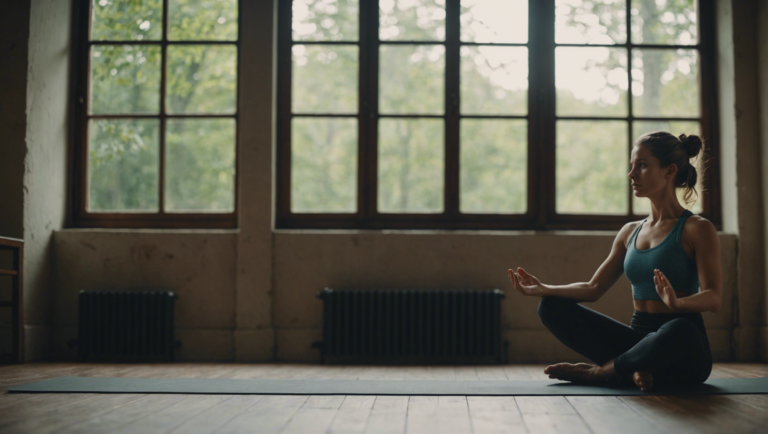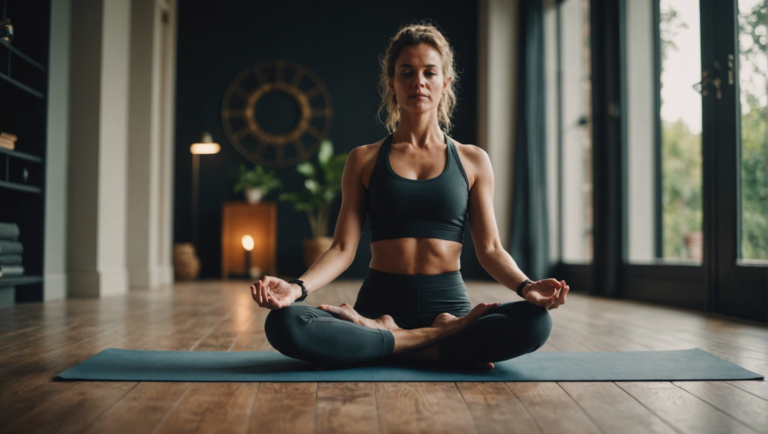Essential Guidelines For Starting A Yoga Class Successfully
Essential Guidelines for Starting a Yoga Class Successfully
When starting a yoga class, it’s essential to lay a strong foundation to ensure success. Whether you’re a seasoned yoga instructor or just starting out, following these guidelines can help you establish a thriving yoga class that benefits both you and your students.
Understanding Your Audience
Before diving into teaching yoga classes, it’s crucial to understand your target audience. Consider the demographics, experience levels, and preferences of the students you aim to attract. Tailoring your classes to meet the needs and interests of your audience can lead to higher engagement and retention rates.
Creating a Welcoming Environment
Creating a welcoming and inclusive space is key to starting a yoga class successfully. Ensure that the yoga studio or venue is clean, well-ventilated, and free of distractions. Greet each student warmly as they arrive and make an effort to learn their names. Encouraging a sense of community and belonging can help students feel comfortable and eager to return.
Planning Your Curriculum
Developing a well-thought-out curriculum is essential for the success of your yoga class. Consider the level of expertise of your students and tailor your sequences and themes accordingly. Incorporate a mix of postures, breathing exercises, relaxation techniques, and meditation to offer a comprehensive yoga experience.
Establishing Clear Goals and Expectations
Communicate clear goals and expectations to your students from the start. Let them know what they can expect to learn and achieve in your class. Encourage them to set their intentions for each session and provide guidance on how they can progress in their practice over time.
Demonstrating Proper Technique
As a yoga instructor, it’s crucial to demonstrate proper technique and alignment in each pose. Ensure that your cues are clear and easy to follow, and provide adjustments when necessary. By modeling correct form and alignment, you can help prevent injuries and support your students in deepening their practice.
Encouraging Mindfulness and Presence
Yoga is not just about physical exercise; it’s also an opportunity to cultivate mindfulness and presence. Encourage your students to focus on their breath, stay present in the moment, and let go of distractions. Incorporate moments of stillness and reflection into your classes to help students connect with their inner selves.
Soliciting and Responding to Feedback
Feedback is a valuable tool for growth and improvement. Encourage your students to provide feedback on your classes, teaching style, and curriculum. Take their comments seriously and use them to make adjustments and enhancements to your yoga class. Showing that you value and respond to feedback can help build trust and loyalty among your students.
Starting a yoga class successfully requires careful planning, attention to detail, and a genuine passion for sharing the practice of yoga. By following these essential guidelines, you can create a nurturing and empowering space where your students can thrive and grow in their yoga journey.
Importance of Establishing Clear Class Objectives
Establishing clear class objectives is crucial in the context of yoga classes as it sets the tone for the entire session and helps participants understand what they can expect to achieve. Clear objectives guide the flow of the class, ensuring that both the instructor and students are aligned in their goals. Let’s delve into the importance of defining clear class objectives in the realm of yoga instruction.
Setting the Foundation for Learning
Clear class objectives serve as the foundation for learning in a yoga class. When students are aware of what they are working towards, it provides them with a sense of direction and purpose. Objectives outline the specific skills or knowledge that participants will gain by the end of the session. For instance, the objectives could include mastering a particular yoga pose, improving flexibility, or learning breathing techniques for relaxation.
Enhancing Focus and Engagement
By clearly stating what the class aims to achieve, instructors can enhance the focus and engagement of their students. When participants know the goals of the session, they are more likely to stay attentive and committed throughout the class. Clear objectives help reduce distractions and keep everyone on track, creating a conducive environment for learning and self-improvement.
Supporting Progress Tracking
Having well-defined objectives allows both instructors and students to track progress effectively. Participants can measure their achievements against the stated goals, providing them with a sense of accomplishment and motivation to continue their yoga practice. Instructors can also assess the effectiveness of their teaching methods based on how well students are meeting the class objectives.
Cultivating a Sense of Achievement
Clear class objectives contribute to cultivating a sense of achievement among participants. When students know what they are working towards and eventually accomplish those goals, it boosts their confidence and self-esteem. Celebrating small wins along the way to achieving the objectives can further motivate students to stay dedicated to their practice and continue exploring the benefits of yoga.
Fostering Communication and Collaboration
Establishing clear objectives encourages open communication between instructors and students. By clearly articulating what is expected of participants, instructors can address any questions or concerns upfront, promoting a collaborative and supportive learning environment. Students feel more comfortable sharing their feedback and seeking guidance when the objectives are transparent.
Establishing clear class objectives is essential for the success of yoga classes. It lays the groundwork for effective learning, enhances student focus and engagement, supports progress tracking, cultivates a sense of achievement, and fosters communication and collaboration. By setting clear objectives, instructors can create a structured and purposeful yoga experience that benefits both the students and the overall class dynamic.
Creating a Welcoming and Inclusive Environment for Participants
Starting a yoga class successfully involves more than just knowing how to teach yoga poses. It also requires creating a welcoming and inclusive environment for all participants. By following essential guidelines and best practices, you can set the tone for a positive and enriching yoga experience for everyone involved.
Importance of Inclusivity in Yoga Classes
Inclusivity is a cornerstone of a successful yoga class. It ensures that everyone, regardless of their background, experience level, or physical abilities, feels welcome and valued. Creating an inclusive environment fosters a sense of community and removes barriers to participation, allowing individuals to fully benefit from the practice of yoga.
Cultivate a Sense of Belonging
To promote inclusivity in your yoga classes, strive to cultivate a sense of belonging among participants. Greet everyone warmly, learn their names, and encourage open communication. Emphasize that your yoga class is a safe space free from judgment, where individuals can explore their practice without fear of criticism.
Provide Modifications and Options
Every individual is unique, with varying levels of flexibility, strength, and mobility. As a yoga instructor, it is essential to provide modifications and options for poses to accommodate different abilities. Encourage participants to listen to their bodies and choose variations that suit their needs, emphasizing that there is no one-size-fits-all approach to yoga.
Use Inclusive Language
Language plays a crucial role in creating an inclusive environment. Be mindful of the words you use and opt for inclusive language that respects all participants. Avoid making assumptions about gender, ability, or body type. Instead, use neutral terms and offer verbal cues that focus on body awareness and alignment.
Embrace Diversity
Diversity enriches the yoga community and brings a wealth of perspectives and experiences to the practice. Celebrate and embrace diversity in your classes by incorporating a range of teaching styles, music, and cultural influences. Encourage participants to share their unique insights and practices, creating a collaborative and inclusive atmosphere.
Foster Mutual Respect and Empathy
In an inclusive yoga class, mutual respect and empathy are essential values. Encourage participants to support and uplift each other, fostering a sense of camaraderie and understanding. Remind everyone that yoga is a personal journey, and each individual’s practice is worthy of respect and encouragement.
Creating a welcoming and inclusive environment for participants is a vital aspect of starting a yoga class successfully. By prioritizing inclusivity, cultivating a sense of belonging, providing modifications, using inclusive language, embracing diversity, and fostering mutual respect and empathy, you can ensure that everyone feels valued and supported in their yoga practice. Remember, the true essence of yoga lies in unity and connection, transcending barriers and celebrating the richness of human experience.
Designing a Structured and Engaging Class Curriculum
Starting a yoga class successfully requires careful planning and a well-thought-out curriculum that is both structured and engaging for students. Designing a class curriculum that caters to the needs of beginners as well as more experienced practitioners is essential to ensure that all participants benefit from the practice. Here are some essential guidelines to help you create a successful yoga class curriculum.
Understanding Your Audience
Before designing your yoga class curriculum, it is crucial to understand the needs and preferences of your target audience. Consider the age group, fitness level, and experience of the participants to tailor the class content accordingly. For beginners, focus on introducing basic yoga poses and breathing techniques, while for more advanced students, you can incorporate challenging asanas and sequences.
Establishing Clear Learning Objectives
Outline clear learning objectives for each class session to guide your curriculum design. Define what you want participants to achieve by the end of the class, whether it is improving flexibility, building strength, reducing stress, or enhancing mindfulness. Setting specific goals will help you create a structured curriculum that progresses logically from one class to the next.
Sequencing Asanas Thoughtfully
The sequence of yoga asanas plays a vital role in the effectiveness of your class curriculum. Start with gentle warm-up poses to prepare the body for more challenging postures later in the session. Incorporate a mix of standing, seated, balancing, and inversions poses to for a well-rounded practice. Ensure smooth transitions between poses to maintain the flow of the class and keep participants engaged.
Integrating Breathwork and Meditation
Pranayama (breathwork) and meditation techniques into your class curriculum can enhance the overall experience for students. Teach various breathing exercises to help participants deepen their practice and improve their focus. Guided meditation at the beginning or end of the class can promote relaxation and mental clarity, enriching the holistic benefits of yoga.
Offering Modifications and Progressions
A successful yoga class curriculum should cater to students of different abilities by offering modifications and progressions for each asana. Encourage participants to listen to their bodies and choose variations that suit their individual needs. Provide options to make poses more accessible for beginners and challenging variations for advanced practitioners to ensure inclusivity and growth for all students.
Creating a Positive Learning Environment
Foster a positive and welcoming to create an environment where students feel comfortable exploring their practice. Use supportive language, offer personalized attention, and provide constructive feedback to motivate and empower participants. Encourage open communication and create a sense of community within the class to enhance the overall learning experience.
Seeking Feedback and Continuous Improvement
Regularly seek feedback from your students to evaluate the effectiveness of your class curriculum and gather insights for improvement. Pay attention to the preferences and suggestions of participants to refine your teaching approach and curriculum design. Stay open to learning and adapting your curriculum to better meet the needs of your students and ensure a rewarding yoga experience for all.
Designing a structured and engaging class curriculum is essential for starting a yoga class successfully. By understanding your audience, establishing clear objectives, thoughtfully sequencing asanas, integrating breathwork and meditation, offering modifications, creating a positive learning environment, and seeking feedback for continuous improvement, you can create a dynamic and enriching yoga class that resonates with your students. Embrace creativity, flexibility, and compassion in your curriculum design to inspire and empower others on their yoga journey.
Utilizing Effective Communication Techniques with Students
Effective Communication Techniques with Students
Effective communication is essential in creating a positive and productive learning environment. When it comes to interacting with students, using the right communication techniques can make a significant difference in their understanding, engagement, and motivation. Here are some essential guidelines for utilizing effective communication techniques with students.
Importance of Active Listening
Active listening is the cornerstone of effective communication. By actively listening to students, educators can demonstrate respect, build trust, and gain valuable insights into their thoughts and feelings. To practice active listening, teachers should focus on the speaker, avoid interrupting, ask clarifying questions, and provide feedback to ensure mutual understanding.
Clear and Concise Language
Using clear and concise language is crucial for ensuring that students understand the information being conveyed. Teachers should avoid using jargon or complex terms that may confuse students. Instead, they should communicate in a straightforward manner, breaking down complex ideas into simpler concepts that are easy to grasp.
Encouraging Two-Way Communication
Effective communication is a two-way street that involves both speaking and listening. Teachers should encourage students to ask questions, share their thoughts, and participate in discussions. By fostering a culture of open communication, educators can create a supportive learning environment where students feel comfortable expressing themselves.
Non-Verbal Communication
Non-verbal communication, such as body language and facial expressions, plays a significant role in conveying messages to students. Teachers should pay attention to their non-verbal cues, ensuring that they are aligned with their verbal communication. Maintaining eye contact, using gestures, and displaying a welcoming posture can enhance the effectiveness of communication in the classroom.
Providing Constructive Feedback
Feedback is a vital component of effective communication. When providing feedback to students, teachers should focus on specific behaviors, offer constructive criticism, and provide actionable steps for improvement. By offering feedback in a positive and constructive manner, educators can motivate students to excel and grow.
Building Rapport and Trust
Building rapport and trust with students is essential for effective communication. Teachers should strive to establish positive relationships, show empathy, and create a supportive atmosphere in the classroom. By building trust with students, educators can facilitate open communication and encourage active participation in the learning process.
Utilizing Technology Wisely
Technology into communication can enhance the learning experience for students. Whether through email, messaging apps, or educational platforms, technology can facilitate communication outside of the classroom and provide additional resources for students. However, it is essential to use technology wisely and ensure that it complements face-to-face interactions rather than replacing them.
Effective communication techniques are vital for fostering a positive and engaging learning environment. By practicing active listening, using clear language, encouraging two-way communication, paying attention to non-verbal cues, providing constructive feedback, building rapport, and utilizing technology wisely, educators can enhance their communication skills and create meaningful connections with students. By prioritizing effective communication, teachers can empower students to succeed academically and personally.
Conclusion
Starting a yoga class successfully requires careful planning, clear communication, and a supportive environment for participants. By following the essential guidelines outlined in this article, yoga instructors can set the stage for a positive and enriching experience for all involved.
Establishing clear class objectives is crucial in guiding the direction of the yoga session and ensuring that participants understand what to expect. By clearly defining the goals of the class, instructors can help students focus their intent and maximize the benefits of their practice.
Creating a welcoming and inclusive environment is essential for fostering a sense of connection and community among participants. By cultivating a space where everyone feels accepted and supported, instructors can encourage students to explore their practice without fear of judgment.
Designing a structured and engaging class curriculum is key to keeping participants motivated and interested in their yoga journey. By incorporating a variety of poses, sequences, and themes, instructors can provide a well-rounded experience that caters to the needs and interests of all students.
Utilizing effective communication techniques with students is vital for building trust and rapport in the yoga class. By offering clear instructions, demonstrations, and feedback, instructors can help students feel confident in their practice and deepen their understanding of yoga principles.
These key elements into the planning and execution of a yoga class can help instructors create a positive and transformative experience for their students. By following these essential guidelines, instructors can start their yoga classes on the right foot and lay the foundation for a successful and fulfilling journey into the practice of yoga.
Remember, the true essence of yoga lies not just in the physical postures, but in the mindful awareness and connection that we cultivate on and off the mat. By approaching each class with authenticity, compassion, and a genuine desire to serve and support others, instructors can create a space where students feel inspired, empowered, and uplifted.
As you embark on your journey as a yoga instructor, keep these essential guidelines in mind and continue to grow and evolve in your practice. By staying true to the principles of yoga and honoring the unique needs and experiences of your students, you can create a yoga class that is not only successful but also deeply meaningful and transformative for all who participate.


